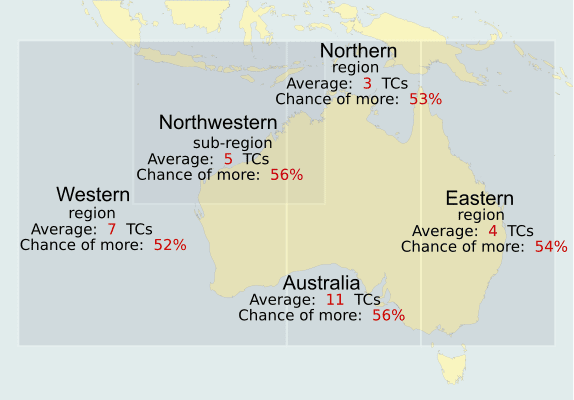% Chance of more tropical cyclones than average:
- Australia: Average: 11 TCs. Chance of more: 56%
- Western region: Average: 7 TCs. Chance of more: 52%
- Northern region: Average: 3TCs. Chance of more: 53%
- Northwestern sub-region region: Average: 5 TCs. Chance of more: 56%
- Eastern region: Average: 4 TCs. Chance of more: 54%
THE Bureau of Meteorology is predicting an average number of cyclones to occur over the 2017–18 Australian tropical cyclone season, which runs from November 2017 to April 2018).
This outlook is based on ENSO-neutral to weak La Niña-like conditions in the tropical Pacific Ocean and slightly warmer-than-average ocean temperatures to the north and east of Australia.
Sea surface temperatures in the tropical Pacific Ocean have cooled since July and are now below average.
The majority of climate models suggest ocean temperatures may cool to La Niña thresholds during summer, although they predict a weak, short-lived event should one occur.
Atmospheric indicators of ENSO remain neutral. Ocean temperatures are currently 0.5 to 1 °C warmer than average to the north and east of Australia which marginally increases the likelihood of cyclones developing.
The outlook indicates that “a typical number” of tropical cyclones is most likely in the Australian region and all sub-regions for 2017–18.
The Australian region has a 56% chance of having more tropical cyclones than average, meaning a 44% chance of having fewer tropical cyclones than average.
Typically, around four tropical cyclones cross the Australian coast in a season. Outlook accuracy for the Australian region is high.
The Western region is likely to experience an average number of tropical cyclones this season, with the likelihood of more than average at 52%. The chance of fewer than average is 48%. Typically between about 15% and 40% of tropical cyclones in the Western region create coastal impacts. Outlook accuracy for the Western region is low.
The Northwestern sub-region has a 56% chance of more tropical cyclones than average and a 44% chance of fewer tropical cyclones than average. Typically, five cyclones form in or pass through this area each season. Around 40% of tropical cyclones, or their associated tropical lows, effect coastal areas of the Northwestern sub-region. Outlook accuracy for this region is moderate.
The Northern region outlook suggests an average number of tropical cyclones with a 53% chance of more tropical cyclones than average and a 47% chance of fewer tropical cyclones than average. In a typical year the Northern region experiences around three cyclones, and one or two tropical lows that later become cyclones after moving into the Western or Eastern regions. About three-quarters of the tropical cyclones in the Northern region impact coastal regions. Outlook accuracy for this region is very low.
The Eastern region outlook shows a near average season is most likely, with a 54% chance of more tropical cyclones than average and a 46% chance of fewer. About a quarter of tropical cyclones in the Eastern region make landfall. Outlook accuracy for this region is low.
On average, there are 10 to 13 tropical cyclones each season in the Australian region, four of which typically cross the coast.At least one tropical cyclone has crossed the Australian coast each season since reliable records began in the 1970s.
During ENSO-neutral years, the first tropical cyclone to make landfall over Australia typically occurs in late December. In La Niña years, the first cyclone landfall typically occurs earlier, around the first week of December.
Tropical lows that do not intensify into cyclones, or lows that are the remnants of older cyclones, can still cause widespread rainfall and dangerous flooding.
These impacts can extend beyond the tropics into southern areas of the country.
Source: BOM




HAVE YOUR SAY